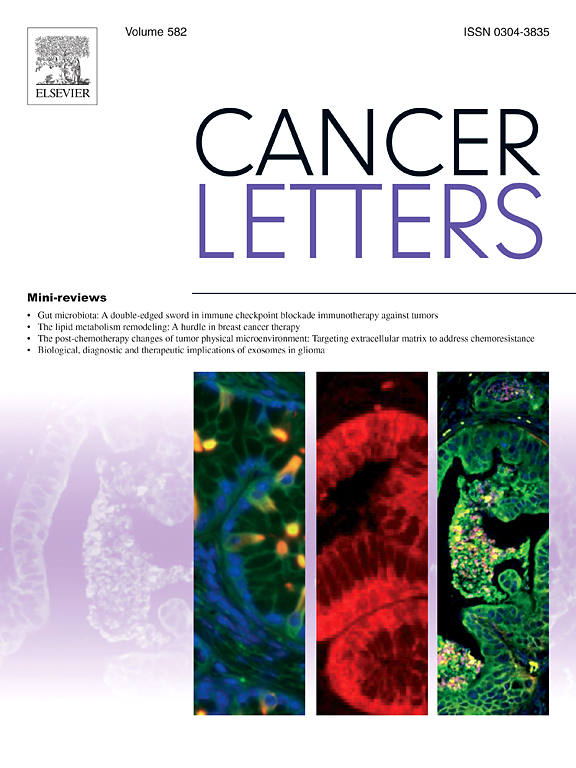Pancreatic cancer precursor lesions – Can immunotherapy prevent progression into pancreatic ductal adenocarcinoma?
IF 9.1
1区 医学
Q1 ONCOLOGY
引用次数: 0
Abstract
Pancreatic ductal adenocarcinoma (PDAC) is one of the deadliest cancers, with a 5-year survival rate of only 12.5 %. Early detection of PDAC or addressing risk factors for PDAC development are ways to improve outcomes. PDAC can arise from precursor lesions, including pancreatic intraepithelial neoplasia (PanIN), intraductal papillary mucinous neoplasm (IPMN), and less frequent, mucinous cystic neoplasm (MCN), and other rare precursor variants. High-risk precursor lesions harbor a substantial chance of evolving into PDAC. Such lesions can often be found in resected PDAC specimens adjacent to the cancer. Unfortunately, recognizing precursor lesions that need to be resected is often tricky, and resections frequently end in major surgical interventions. Thus, better ways to handle precursor lesions are desperately needed. We mapped the immune microenvironments (IMEs) of PanINs, IPMNs, and MCNs on a cellular level using multiplex immunofluorescence and computational imaging technology and compared the findings to PDACs and normal pancreatic tissues. We found distinct and potentially targetable mechanisms of immunosuppression between the two main precursor lesions, PanIN and IMPN. Immunosuppression in IPMNs seems partly mediated by programmed cell death protein 1 ligand (PD-L1) expression on antigen-presenting cells (APCs). By contrast, elevated numbers of regulatory T cells (Tregs) seem to be key players in the immunosuppression of PanINs. Thus, treating high-risk IPMNs with anti-PD-1 and high-risk PanINs with agents targeting Tregs, such as anti-lymphocyte associated protein 4 (anti-CTLA-4) antibodies, could reverse their immunosuppressive state. Reversal of immunosuppression will restore immunosurveillance and eventually prevent progression into PDAC. We also review relevant published and ongoing non-surgical treatment approaches for high-risk IPMNs and PanINs.
胰腺癌前驱病变-免疫治疗能预防进展为胰腺导管腺癌吗?
胰腺导管腺癌(PDAC)是最致命的癌症之一,其5年生存率仅为12.5%。早期发现PDAC或解决PDAC发展的风险因素是改善结果的方法。PDAC可由前体病变引起,包括胰腺上皮内瘤变(PanIN)、导管内乳头状粘液瘤(IPMN)、少见的粘液囊性肿瘤(MCN)和其他罕见的前体变异体。高风险的前体病变有很大的机会演变为PDAC。这种病变通常可以在癌旁切除的PDAC标本中发现。不幸的是,识别需要切除的前驱病变往往是棘手的,而切除往往以大手术干预告终。因此,迫切需要更好的方法来处理前驱病变。我们利用多重免疫荧光和计算成像技术在细胞水平上绘制了PanINs、IPMNs和MCNs的免疫微环境(IMEs),并将结果与pdac和正常胰腺组织进行了比较。我们发现了两种主要前体病变PanIN和IMPN之间不同的潜在靶向免疫抑制机制。IPMNs的免疫抑制似乎部分由抗原呈递细胞(APCs)上的程序性细胞死亡蛋白1配体(PD-L1)表达介导。相比之下,调节性T细胞(Tregs)数量的升高似乎是PanINs免疫抑制的关键角色。因此,用靶向Tregs的抗淋巴细胞相关蛋白4 (anti-CTLA-4)抗体等药物治疗高危IPMNs,可逆转其免疫抑制状态。免疫抑制的逆转将恢复免疫监视并最终防止进展为PDAC。我们还回顾了高风险IPMNs和PanINs的相关已发表和正在进行的非手术治疗方法。
本文章由计算机程序翻译,如有差异,请以英文原文为准。
求助全文
约1分钟内获得全文
求助全文
来源期刊

Cancer letters
医学-肿瘤学
CiteScore
17.70
自引率
2.10%
发文量
427
审稿时长
15 days
期刊介绍:
Cancer Letters is a reputable international journal that serves as a platform for significant and original contributions in cancer research. The journal welcomes both full-length articles and Mini Reviews in the wide-ranging field of basic and translational oncology. Furthermore, it frequently presents Special Issues that shed light on current and topical areas in cancer research.
Cancer Letters is highly interested in various fundamental aspects that can cater to a diverse readership. These areas include the molecular genetics and cell biology of cancer, radiation biology, molecular pathology, hormones and cancer, viral oncology, metastasis, and chemoprevention. The journal actively focuses on experimental therapeutics, particularly the advancement of targeted therapies for personalized cancer medicine, such as metronomic chemotherapy.
By publishing groundbreaking research and promoting advancements in cancer treatments, Cancer Letters aims to actively contribute to the fight against cancer and the improvement of patient outcomes.
 求助内容:
求助内容: 应助结果提醒方式:
应助结果提醒方式:


